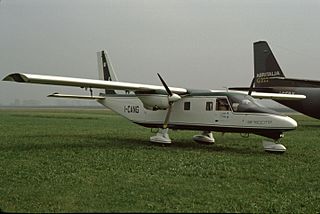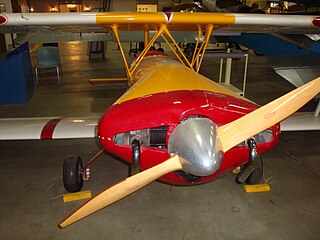Related Research Articles
The ACME Anser was an amphibious twin-jet utility aircraft that was developed in the United States by Air Craft Marine Engineering in 1958. The project was cancelled before the prototype was complete.

The SZD-45 Ogar (Greyhound) is a T-tailed cantilever high-wing monoplane of wooden, aluminium and fibreglass construction designed and manufactured in Poland.

The ASH 26 is an 18 metre Class glider, built of modern fibre reinforced composites. It first flew in 1993. It is manufactured by Alexander Schleicher GmbH & Co. The 'H' indicates this is a design of Martin Heide.
The LIPNUR Kunang was a single-seat sports plane built in Indonesia that first flew in 1958 in the hope that it would inspire interest in aviation amongst Indonesian youth. The only example that was built was subsequently grounded. It was a single-seat monoplane of conventional layout with fixed tailwheel undercarriage.

The Brügger MB-1, MB-2 and MB-3 Colibri is a family of small sports aircraft designed in Switzerland in the 1960s and 1970s for amateur construction.
The Cvjetkovic CA-61 Mini-Ace is a 1960s American homebuilt monoplane aircraft designed by Anton Cvjetkovic.

The Caproni Vizzola C22 Ventura was a light jet-powered aircraft developed in Italy for use as a military trainer. It was of conventional sailplane configuration and bore a family resemblance to the Caproni Calif gliders, although the Ventura had an almost entirely metal structure. The student and instructor sat side by side under an expansive canopy, and weapons hardpoints were provided under each of the slender, high-mounted wings. It had retractable, tricycle undercarriage.

The VSO 10 Vosa is a Standard and Club-Class glider designed and manufactured in the Czechoslovak Republic from December 1978 as a replacement for the VT-116 Orlik II.
The Gatard Statoplan AG 02 Poussin was a light, single-seat sports airplane developed in France in the late 1950s and marketed for homebuilding. In layout, it was a low-wing cantilever monoplane of short-coupled design with fixed tailwheel undercarriage. Construction was a plywood-covered wooden structure throughout, and the cockpit was enclosed by a large perspex bubble canopy. The variable-incidence horizontal stabiliser was fitted with small endplates to provide extra directional stability but there were no separate elevators.

The Vulcanair SF.600 Canguro was a feederliner developed in Italy in the late 1970s. Despite a number of attempts to put the aircraft into series production, only a small number were ever built. The Canguro was a high-wing cantilever monoplane of conventional configuration with a fuselage of rectangular cross-section and a high-set tail. The tricycle undercarriage was not retractable, and its main units were carried on sponsons on the fuselage sides. SIAI Marchetti provided funding towards the construction of the prototype, and constructed this aircraft at the former Aviamilano plant. After flight testing proved positive, the type was put on sale, but failed to attract buyers in any number, even when the original piston engines were exchanged for turboprops and retractable undercarriage was offered as an option.
The Hispano HS-42 and its derivative, the HA-43, were advanced military trainer aircraft produced in Spain in the 1940s. The basic design was that of a conventional, low-wing, cantilever monoplane with seating for the pilot and instructor in tandem. The HS-42 had fixed, tailwheel undercarriage with spatted mainwheels, while the HA-43 had retractable main units. Produced on the assembly line that had been used to build Fokker D.XXI fighters, the HS-42 shared some components with this aircraft.
The Jamieson J was a four-seat utility aircraft built in the United States in the early 1960s. It was designed and constructed by Jamieson Corp, which had been purchasing military surplus Culver Cadets and remanufacturing them for the civil market. Jamieson's first aircraft was the J-1 Jupiter built in 1949 which had a V-tail replacing the standard type tail of the Cadet. What made the Jupiter attractive to the private plane market was its price of $2500. Four Jupiters were produced. The 1960s Model J was patterned closely on the Cadet as the earlier J-1 Jupiter was, but was a larger, new-built aircraft. Like its forerunner it was a conventional, low-wing cantilever monoplane, but featured retractable tricycle undercarriage.

The Wassmer WA-40 Super 4 Sancy is a French single-engined light aircraft of the 1960s and 70s. A single-engined low-winged monoplane with retractable nosewheel undercarriage, variants include the more powerful WA 4/21 Prestige and the WA-41 Baladou with a fixed undercarriage.

The Valentin Taifun is a two-seat self-launching sailplane designed and built by Valentin Flugzeugbau GmbH of Hasfurt, Germany.
The Chengdu X-7 Jian Fan is a Chinese basic trainer glider. First flying in 1966, at least 130 were built.
The Akaflieg Darmstadt D-39 was a single-seat motor glider derived from the D-38 sailplane. Built in Germany in the late 1970s, it was not intended for production and only one was constructed.

The Turbay T-3A was an Argentine twin-engined seven-seater light transport of the 1960s. A single example was built, but no production followed.
The Civil Aviation Department MG-1 was a one-off Indian motor glider, seating two side by side and first flown in 1983.
The Aérostructure Lutin 80, earlier known as the PLM 80, is a small, single seat motor glider with a low power pusher configuration engine, designed and built in France in the 1980s. Only two were completed.

The Der Kricket DK-1 is a single seat, single engine biplane designed and built in the United States in the 1970s with an emphasis on simplicity. Several were built, as intended, by amateurs from plans in addition to some constructed by the four man design consortium.
References
- 1 2 3 Taylor, John W. R. (1981). Jane's All the World's Aircraft 1981–1982. London: Jane's Information Group. p. 514. ISBN 0710607059.